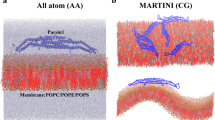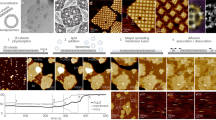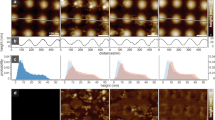Abstract
In Gram-positive bacteria, a thick cross-linked cell wall separates the membrane from the extracellular space. Some surface-exposed proteins, such as the Listeria monocytogenes actin nucleation-promoting factor ActA, remain associated with the bacterial membrane but somehow thread through tens of nanometres of cell wall to expose their amino terminus to the exterior. Here, we report that entropy enables the translocation of disordered transmembrane proteins through the Gram-positive cell wall. We build a physical model, which predicts that the entropic constraint imposed by a thin periplasm is sufficient to drive the translocation of an intrinsically disordered protein such as ActA across a porous barrier similar to a peptidoglycan cell wall. We experimentally validate our model and show that ActA translocation depends on the cell-envelope dimensions and disordered-protein length, and that translocation is reversible. We also show that disordered regions of eukaryotic proteins can translocate Gram-positive cell walls via entropy. We propose that entropic forces are sufficient to drive the translocation of specific proteins to the outer surface.
This is a preview of subscription content, access via your institution
Access options
Access Nature and 54 other Nature Portfolio journals
Get Nature+, our best-value online-access subscription
$29.99 / 30 days
cancel any time
Subscribe to this journal
Receive 12 digital issues and online access to articles
$119.00 per year
only $9.92 per issue
Buy this article
- Purchase on Springer Link
- Instant access to full article PDF
Prices may be subject to local taxes which are calculated during checkout






Similar content being viewed by others
Data availability
All data are available upon request from the corresponding authors. Source data are provided with this paper.
Code availability
All custom scripts are available at https://bitbucket.org/kchuanglab/acta_code/src/master/.
References
Finlay, B. B. & Falkow, S. Common themes in microbial pathogenicity revisited. Microbiol. Mol. Biol. Rev. 61, 136–169 (1997).
Pizarro-Cerda, J. & Cossart, P. Bacterial adhesion and entry into host cells. Cell 124, 715–727 (2006).
Demchick, P. & Koch, A. L. The permeability of the wall fabric of Escherichia coli and Bacillus subtilis. J. Bacteriol. 178, 768–773 (1996).
Forster, B. M. & Marquis, H. Protein transport across the cell wall of monoderm Gram-positive bacteria. Mol. Microbiol. 84, 405–413 (2012).
Schneewind, O. & Missiakas, D. M. Protein secretion and surface display in Gram-positive bacteria. Philos. Trans. R. Soc. B 367, 1123–1139 (2012).
Matias, V. R. & Beveridge, T. J. Cryo-electron microscopy reveals native polymeric cell wall structure in Bacillus subtilis 168 and the existence of a periplasmic space. Mol. Microbiol. 56, 240–251 (2005).
Rafelski, S. M. & Theriot, J. A. Mechanism of polarization of Listeria monocytogenes surface protein ActA. Mol. Microbiol. 59, 1262–1279 (2006).
Welch, M. D., Rosenblatt, J., Skoble, J., Portnoy, D. A. & Mitchison, T. J. Interaction of human Arp2/3 complex and the Listeria monocytogenes ActA protein in actin filament nucleation. Science 281, 105–108 (1998).
Kocks, C. et al. L. monocytogenes-induced actin assembly requires the actA gene product, a surface protein. Cell 68, 521–531 (1992).
Tilney, L. G. & Portnoy, D. A. Actin filaments and the growth, movement, and spread of the intracellular bacterial parasite, Listeria monocytogenes. J. Cell Biol. 109, 1597–1608 (1989).
Kocks, C. et al. The unrelated surface proteins ActA of Listeria monocytogenes and IcsA of Shigella flexneri are sufficient to confer actin-based motility on Listeria innocua and Escherichia coli respectively. Mol. Microbiol. 18, 413–423 (1995).
Smith, G. A., Portnoy, D. A. & Theriot, J. A. Asymmetric distribution of the Listeria monocytogenes ActA protein is required and sufficient to direct actin-based motility. Mol. Microbiol. 17, 945–951 (1995).
Beckerle, M. C. Spatial control of actin filament assembly: lessons from Listeria. Cell 95, 741–748 (1998).
Footer, M. J., Lyo, J. K. & Theriot, J. A. Close packing of Listeria monocytogenes ActA, a natively unfolded protein, enhances F-actin assembly without dimerization. J. Biol. Chem. 283, 23852–23862 (2008).
Housden, N. G. et al. Intrinsically disordered protein threads through the bacterial outer-membrane porin OmpF. Science 340, 1570–1574 (2013).
Driessen, A. J. & Nouwen, N. Protein translocation across the bacterial cytoplasmic membrane. Annu. Rev. Biochem. 77, 643–667 (2008).
Silhavy, T. J., Kahne, D. & Walker, S. The bacterial cell envelope. Cold Spring Harb. Perspect. Biol. 2, a000414 (2010).
Dubrac, S., Bisicchia, P., Devine, K. M. & Msadek, T. A matter of life and death: cell wall homeostasis and the WalKR (YycGF) essential signal transduction pathway. Mol. Microbiol. 70, 1307–1322 (2008).
Devine, K. M. Bacterial L-forms on tap: an improved methodology to generate Bacillus subtilis L-forms heralds a new era of research. Mol. Microbiol. 83, 10–13 (2012).
Wu, X. C., Lee, W., Tran, L. & Wong, S. L. Engineering a Bacillus subtilis expression-secretion system with a strain deficient in six extracellular proteases. J. Bacteriol. 173, 4952–4958 (1991).
Zuber, B. et al. Granular layer in the periplasmic space of Gram-positive bacteria and fine structures of Enterococcus gallinarum and Streptococcus gordonii septa revealed by cryo-electron microscopy of vitreous sections. J. Bacteriol. 188, 6652–6660 (2006).
Gouin, E., Dehoux, P., Mengaud, J., Kocks, C. & Cossart, P. iactA of Listeria ivanovii, although distantly related to Listeria monocytogenes actA, restores actin tail formation in an L. monocytogenes actA mutant. Infect. Immun. 63, 2729–2737 (1995).
Kreft, J., Dumbsky, M. & Theiss, S. The actin-polymerization protein from Listeria ivanovii is a large repeat protein which shows only limited amino acid sequence homology to ActA from Listeria monocytogenes. FEMS Microbiol. Lett. 132, 181–182 (1995).
Yamada, J. et al. A bimodal distribution of two distinct categories of intrinsically disordered structures with separate functions in FG nucleoporins. Mol. Cell Proteom. 9, 2205–2224 (2010).
Matias, V. R. & Beveridge, T. J. Native cell wall organization shown by cryo-electron microscopy confirms the existence of a periplasmic space in Staphylococcus aureus. J. Bacteriol. 188, 1011–1021 (2006).
DeDent, A. C., McAdow, M. & Schneewind, O. Distribution of protein A on the surface of Staphylococcus aureus. J. Bacteriol. 189, 4473–4484 (2007).
DeDent, A., Bae, T., Missiakas, D. M. & Schneewind, O. Signal peptides direct surface proteins to two distinct envelope locations of Staphylococcus aureus. EMBO J. 27, 2656–2668 (2008).
Alonzo, F. 3rd & Freitag, N. E. Listeria monocytogenes PrsA2 is required for virulence factor secretion and bacterial viability within the host cell cytosol. Infect. Immun. 78, 4944–4957 (2010).
Bauer, B. W., Shemesh, T., Chen, Y. & Rapoport, T. A. A “push and slide” mechanism allows sequence-insensitive translocation of secretory proteins by the SecA ATPase. Cell 157, 1416–1429 (2014).
Downer, R., Roche, F., Park, P. W., Mecham, R. P. & Foster, T. J. The elastin-binding protein of Staphylococcus aureus (EbpS) is expressed at the cell surface as an integral membrane protein and not as a cell wall-associated protein. J. Biol. Chem. 277, 243–250 (2002).
Okuda, S., Freinkman, E. & Kahne, D. Cytoplasmic ATP hydrolysis powers transport of lipopolysaccharide across the periplasm in E. coli. Science 338, 1214–1217 (2012).
Pavlovic-Lazetic, G. M. et al. Bioinformatics analysis of disordered proteins in prokaryotes. BMC Bioinform. 12, 66 (2011).
Peng, K., Radivojac, P., Vucetic, S., Dunker, A. K. & Obradovic, Z. Length-dependent prediction of protein intrinsic disorder. BMC Bioinform. 7, 208 (2006).
Cacciuto, A. & Luijten, E. Confinement-driven translocation of a flexible polymer. Phys. Rev. Lett. 96, 238104 (2006).
Gopinathan, A. & Kim, Y. W. Polymer translocation in crowded environments. Phys. Rev. Lett. 99, 228106 (2007).
Luo, K., Metzler, R., Ala-Nissila, T. & Ying, S. C. Polymer translocation out of confined environments. Phys. Rev. E 80, 021907 (2009).
Muthukumar, M. Translocation of a confined polymer through a hole. Phys. Rev. Lett. 86, 3188–3191 (2001).
Muthukumar, M. Molecular modelling of nucleation in polymers. Philos. Trans. A 361, 539–556 (2003).
Park, P. J. & Sung, W. Polymer release out of a spherical vesicle through a pore. Phys. Rev. E 57, 730 (1998).
Rubinstein, M. & Colby, R. H. Polymer Physics Vol. 23 (Oxford Univ. Press, 2003).
Sung, W. & Park, P. J. Polymer translocation through a pore in a membrane. Phys. Rev. Lett. 77, 783–786 (1996).
Edwards, M. R. & Stevens, R. W. Fine structure of Listeria monocytogenes. J. Bacteriol. 86, 414–428 (1963).
North, R. J. Some structural aspects of Listeria Monocytogenes. J. Ultrastruct. Res. 59, 187–197 (1963).
De Gennes, P.-G. & Gennes, P.-G. Scaling Concepts in Polymer Physics (Cornell Univ. Press, 1979).
Clisby, N. & Dunweg, B. High-precision estimate of the hydrodynamic radius for self-avoiding walks. Phys. Rev. E 94, 052102 (2016).
Flory, P. Principles of Polymer Chemistry (Cornell Univ. Press, 1971).
Grundling, A., Gonzalez, M. D. & Higgins, D. E. Requirement of the Listeria monocytogenes broad-range phospholipase PC-PLC during infection of human epithelial cells. J. Bacteriol. 185, 6295–6307 (2003).
Shen, A., Kamp, H. D., Grundling, A. & Higgins, D. E. A bifunctional O-GlcNAc transferase governs flagellar motility through anti-repression. Genes Dev. 20, 3283–3295 (2006).
Ripio, M. T., Brehm, K., Lara, M., Suarez, M. & Vazquez-Boland, J. A. Glucose-1-phosphate utilization by Listeria monocytogenes is PrfA dependent and coordinately expressed with virulence factors. J. Bacteriol. 179, 7174–7180 (1997).
Ripio, M. T. et al. Transcriptional activation of virulence genes in wild-type strains of Listeria monocytogenes in response to a change in the extracellular medium composition. Res. Microbiol. 147, 371–384 (1996).
Maul, B., Volker, U., Riethdorf, S., Engelmann, S. & Hecker, M. σB-Dependent regulation of gsiB in response to multiple stimuli in Bacillus subtilis. Mol. Gen. Genet. 248, 114–120 (1995).
Nguyen, H. D. et al. Construction of plasmid-based expression vectors for Bacillus subtilis exhibiting full structural stability. Plasmid 54, 241–248 (2005).
Lauer, P., Chow, M. Y., Loessner, M. J., Portnoy, D. A. & Calendar, R. Construction, characterization, and use of two Listeria monocytogenes site-specific phage integration vectors. J. Bacteriol. 184, 4177–4186 (2002).
Schneewind, O., Mihaylova-Petkov, D. & Model, P. Cell wall sorting signals in surface proteins of Gram-positive bacteria. EMBO J. 12, 4803–4811 (1993).
Ursell, T. et al. Rapid, precise quantification of bacterial cellular dimensions across a genomic-scale knockout library. BMC Biol. 15, 17 (2017).
Loessner, M. J., Kramer, K., Ebel, F. & Scherer, S. C-terminal domains of Listeria monocytogenes bacteriophage murein hydrolases determine specific recognition and high-affinity binding to bacterial cell wall carbohydrates. Mol. Microbiol. 44, 335–349 (2002).
Laemmli, U. K. Cleavage of structural proteins during the assembly of the head of bacteriophage T4. Nature 227, 680–685 (1970).
Koontz, L. TCA precipitation. Methods Enzymol. 541, 3–10 (2014).
Krogh, A., Larsson, B., von Heijne, G. & Sonnhammer, E. L. Predicting transmembrane protein topology with a hidden Markov model: application to complete genomes. J. Mol. Biol. 305, 567–580 (2001).
Bendtsen, J. D., Nielsen, H., von Heijne, G. & Brunak, S. Improved prediction of signal peptides: SignalP 3.0. J. Mol. Biol. 340, 783–795 (2004).
Fischetti, V. A., Pancholi, V. & Schneewind, O. Conservation of a hexapeptide sequence in the anchor region of surface proteins from Gram-positive cocci. Mol. Microbiol. 4, 1603–1605 (1990).
Schneewind, O., Model, P. & Fischetti, V. A. Sorting of protein A to the staphylococcal cell wall. Cell 70, 267–281 (1992).
Letunic, I. & Bork, P. Interactive Tree Of Life (iTOL): an online tool for phylogenetic tree display and annotation. Bioinformatics 23, 127–128 (2007).
Acknowledgements
We thank M. Rexach for the antibody against Nsp1; W. Burkholder, A. Cheung, T. Burke, and D. Portnoy for strains; and J. Lynch, K. Schulz, H. Shi, M. Tsuchida, and S. Weber for comments on the manuscript. Electron microscopy was performed at, and with the assistance of, the Stanford Cell Sciences Imaging Facility. This work was supported by the National Institutes of Health (NIH) grant no. R37AI-36929 (to J.A.T.); an NSF CAREER Award (grant no. MCB-1149328 to K.C.H.); NSF grant nos. DBI-0960480, DMS-1616926, and HRD-1547848 (to A.G.), and EF-1038697 (to A.G. and K.C.H.); a James S. McDonnell Foundation Award (to A.G.); the Allen Center for Systems Modeling of Infection (to K.M.N. and K.C.H.) and HHMI (to J.A.T.). The project was supported, in part, by an ARRA Award (grant no. 1S10RR026780-01) from the National Center for Research Resources (NCRR); its contents are solely the responsibility of the authors and do not necessarily represent the official views of the NCRR or the NIH. K.C.H. is a Chan Zuckerberg Biohub Investigator.
Author information
Authors and Affiliations
Contributions
D.K.H., F.E.O., K.C.H. and J.A.T. designed the experiments, analysed the data and wrote the manuscript. D.K.H., F.E.O., M.J.F. and J.A.T. performed the experiments. D.K.H. and K.M.N. constructed the mutants. A.G. and K.C.H. developed the model. N.S.M. and S.N.M. performed the disorder predictions. All authors reviewed the manuscript before submission.
Corresponding authors
Ethics declarations
Competing interests
The authors declare no competing interests.
Additional information
Peer review information Nature Microbiology thanks the anonymous reviewers for their contribution to the peer review of this work.
Publisher’s note Springer Nature remains neutral with regard to jurisdictional claims in published maps and institutional affiliations.
Extended data
Extended Data Fig. 1 Predicted critical lengths for an ActA-like polymer for different values of cell wall thickness, periplasm thickness and pore radius.
a) Critical length as a function of periplasm thickness P for different values of cell wall thickness w, with pore radius R set at 3 nm. Each curve denotes a different cell wall thickness, with w ranging from 10 nm to 40 nm. b) Critical length as a function of periplasm thickness P for different values of R, with w set at 20 nm. c) Critical length as a function of cell wall thickness w for different values of R, with P set at 12 nm. In (b,c), each curve denotes a different pore radius, with R ranging from 2 nm to 4.2 nm. For all graphs the thickest line signifies parameters used in Fig. 1: w = 20 nm, P = 12 nm, R = 3 nm. The dashed horizontal line denotes the length of an ActA molecule. The entropic model predicts that any parameter set resulting in a critical length falling below this dashed line will result in proper translocation of ActA. All parameter values were chosen so that 2R and P are substantially more than the persistence length of ActA.
Extended Data Fig. 2 Effects of TEV protease treatment on surface presentation of ActA.
A representative TEV cleavage experiment showing population distributions of untreated and TEV protease-treated conditions for strains in Fig. 2d,e after labelling with α−ActA-PRR.
Extended Data Fig. 3 Genetic truncations of ActA were detected at expected lengths.
-100 and -200 refer to 100- and 200-amino acid truncation mutants, respectively. SDS treatment (S) and mechanical disruption by bead-beating (B) as in Fig. 1a,b were performed for all strains labelled with α−ActA-PRR. Arrows indicate (from left to right) full-length ActA, the 100-amino acid truncation, and the 200-amino acid truncation.
Extended Data Fig. 4 Lack of immunofluorescence signal for Nsp1 constructs that are secreted or anchored by transmembrane domains at both termini.
a) Western blotting showed stable expression of the Nsp1 chimaeric construct (arrow) from Fig. 5a,b. b) Polar distribution of ActA in the wild-type strain of L. monocytogenes using an antibody against ActA. c) Lack of signal in the wild-type strain using an antibody against Nsp1. d) Immunofluorescence of Nsp1 expressed with an amino-terminal signal sequence from ActA but no transmembrane anchor. e) Nsp1 expressed with an amino-terminal transmembrane domain from lmo2229 and carboxy-terminal5 transmembrane domain from ActA. No visible labelling was observed when Nsp1 was anchored at both ends, confirming that antibodies do not label proteins that are trapped in the periplasm.
Extended Data Fig. 5 Time course of disordered protein localization and polarization in L. monocytogenes.
a) ActA expressed from the ActA promoter. b) Nsp1, with a signal sequence and transmembrane domain from ActA, expressed from the ActA promoter.
Extended Data Fig. 6 ActA expression, translocation, and exposure, as well as VASP binding and comet-tail formation, were maintained in ∆prsA2 cells.
a) Expression of listeriolysin O (arrow) was lower in two prsA2 transposon insertion mutants, as expected, but similar to wild type in a ∆actA mutant, as shown in a Coomassie-stained gel of TCA-precipitated culture supernatant. b) Expression of ActA (arrow) in prsA2 cells determined using α−ActA decreased to a similar extent as listeriolysin O in (a); no expression was detected in ∆actA cells. Levels were similar between cells treated with SDS (S) or subjected to bead-beating (B), indicating that most ActA was translocated across the cell wall. c) Immunofluorescence labelling with α−ActA confirmed that ActA was exposed on the surface of wild-type and prsA2 cells. d) The EVH1 domain of VASP fused to GST bound to the surface of prsA2 and wild-type cells expressing wild-type ActA, but not to a ∆actA cells. GST alone also did not bind the surface of wild-type bacteria. Shown is immunofluorescence labelling of GST. e) Wild-type and prsA2 L. monocytogenes formed comet tails in host cells, but ∆actA L. monocytogenes did not. Actin was labelled with phalloidin. Thus, PrsA2 is not required for ActA translocation or function.
Supplementary information
Source data
Source Data Fig. 2
Immunofluorescence analysis.
Source Data Fig. 3
Immunofluorescence analysis.
Source Data Extended Data Fig. 6
Immunofluorescence analysis.
Rights and permissions
About this article
Cite this article
Halladin, D.K., Ortega, F.E., Ng, K.M. et al. Entropy-driven translocation of disordered proteins through the Gram-positive bacterial cell wall. Nat Microbiol 6, 1055–1065 (2021). https://doi.org/10.1038/s41564-021-00942-8
Received:
Accepted:
Published:
Issue Date:
DOI: https://doi.org/10.1038/s41564-021-00942-8
This article is cited by
-
The molecular basis for cellular function of intrinsically disordered protein regions
Nature Reviews Molecular Cell Biology (2024)
-
Streamlining N-terminally anchored yeast surface display via structural insights into S. cerevisiae Pir proteins
Microbial Cell Factories (2023)
-
Proteins sorted by ‘chaos and disorder’
Nature Microbiology (2021)



